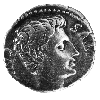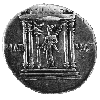| Wealth is indeed useful,
since it is both an embellishment for those who possess it, and the means
by which they may exercise virtue. It is also of benefit to one's sons,
who can by means of it rise more easily to positions of honor and distinction
[Leonardo Bruni, Preface to Book I of the Aristotelian Treatise on Economics,
or Family Estate Management Addressed to Cosimo de' Medici: p. 305]....
|
Richard Goldthwaite,
Wealth and the Demand for Art in Italy 1300-1600:
p. 206: ...Petrarch and the first generation of his followers
at the end of the fourteenth century who upheld the model of the contemplative
life, had embraced the ideal of poverty, inspired no doubt by Franciscan spirituality
but also by the Stoic doctrine of indifference to material things found in some
Roman writers.... The next generation of humanists, however, had very different
ideas, especially those Florentines who addressed themselves not so much to
other intellectuals as to a public of wealthy entrepreneurs. They discovered
a different side of Aristotle --above all, in the pseudo-Aristotelian Economics,
translated and edited by Leonardo Bruni --that opposed poverty and reevaluated
the importance of private wealth for both the well-being of society and the
self-fulfillment of the individual. Bruni, Alberti, and Matteo Palmieri, far
from condemning wealth, or being suspicious of it, now extolled it as a necessary
condition for the exercise of virtue in the active life. Wealth presents a moral
challenge because it puts virtue to the test in ways not experienced by the
person who is not burdened by the encumbrances of material possessions. These
Florentine writers assumed an active involvement in civic life, where the rich
have a special role to play; and they recognized both the reputation and the
special authority the rich enjoy among their fellows. What these intellectuals
were in fact doing was establishing the nobility of a wealthy upper class that
had no cultural traditions to appeal to for underpinning its status: its only
credential was wealth and what wealth could buy --political power and social
status....
The central problem that had to be addressed was the proper use
of wealth. The humanists considered the problem entirely in secular terms, although
their reliance on classical sources, above all Aristotle, who had exercised
so much influence throughout the Middle Ages, gave their arguments a familiar
ring. For them wealth does indeed have a usefulness beyond the traditional claims
on it by charity and good works, and this usefulness can be entirely a matter
of private advantage / p. 207: and pleasure.... To an extent they defined the
usefulness of wealth in the traditional aristocratic terms of glory seeking,
albeit now in a civic context; but the consumption model the humanists came
up with was not the traditional one of the feudal nobility. It reflected the
new habits of spending that possessed Italians at the time: it centered on architecture.
As indicated in the previous section, the quality of magnificence associated
with architecture was highly touted throughour the fifteenth century by numerous
writers.
| Magnificence is a more elevated form of liberality having to do with enormous
expenditures --for example, when someone builds a public theater, or sponsors
the Megalensian Games, or a gladiatorial show, or a public banquet. These
acts, and acts of this sort which surpass the powers of the average private
person, have a certain aura of greatness about them and are spoken of, not
simply as liberal, but as magnificent [Leonardo Bruni, An Isagogue of
Moral Philosophy, p. 276].... |
Magnificence is the key term in the discussion by the humanists
of the positive uses of wealth. In dealing with the subject they of course referred
to classical authorities; but at the same time they were also appropriating
a medieval notion associated with the uses of wealth by princes. Feudal princes
became more self-conscious about magnificence when they began to lead a more
settled existence. The concept involved the splendor with which they sought
to endow their presence with the authority of their position in the feudal hierarchy,
but it also called for generosity in the spirit of virtuous liberality. Medieval
discussions of liberality, largely inspired by Aristotle, focused on the right
uses of wealth: liberality was the mean between the extremes of the vices of
prodigality and avarice. It was, however, a princely virtue involving those
gestures of spectacle, feasts, gifts, and charity by which a prince asserted
a public presence.... Magnificence, in a sense,was a rationalization for luxury,
which was otherwise condemned as sinful and unnatural. In the courtly literature
of England, which has been carefully combed for usage of the term, magnificence
was synonymous with magnanimity and was inextricably associated with the Christian
concept of nobility; and it was demonstrated in generous and splendid hospitality
on a grand public scale. This sense of term continues to find expression in
the literary tradition through the Renaissance and into the seventeenth century....
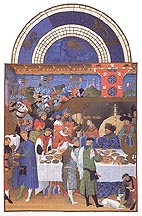
The
January page from the Très riches heures presents a good
example of what Goldthwaite calls princely magnificence. In this miniature
the patron of the manuscript, Jean duc de Berry is shown celebrating
the New Years Day feast of étrennes. He and the rest of
his court is turned out in luxurious fabrics. On the side board are
exhibited the luxurious metalwork which were presumably gifts exchanged
at this feast. In the background hangs a tapestry illustrating the Fall
of Troy which provided the medieval noble the model of a good warrior.
The feast of étrennes was specifically associated with
the renewal of allegiances. The gifts exchanged gave physical testament
to the personal allegiances.
|
/p. 208: In Italy the term
underwent a redefinition to fit a nonfeudal society. The basic meaning remained
the same: magnificence is the use of wealth in a way that manifests those qualities
that express one's innate dignity, thereby establishing one's reputation by
arousing the esteem and admiration of others. But it is now distinct from princely
magnanimity and largely deprived of its overtone of Christian charity. It becomes
associated with that greatness of spirit so characteristic of the humanists'
notion of the civic nature of man. True to the Aristotelian idea, however, it
is regarded as a social concept, involving a grand gesture made toward the collectivity
of society if for no other reason than it provided a spectacle on the public
stage.
Also truer to the original
discussion of the concept in Aristotle, the Italians explicitly associate magnificence
with the proper use of wealth and money in general and not just by princes in
particular; it is a virtue that only the rich can possess.... Giovanni Pontano,
who takes up the subject in a tract written on just those social virtues that
involve the spending of money, opens his discussion calling magnificence the
"fruit" of wealth. Although magnificence involves an extraordinary
manifestation of wealth and luxury, these writers shift the emphasis from expenditures
for the public good to private expenditures to establish one's public reputation
or simply to give one pleasure. Aristotle had emphasized the public-spirited
nature of magnificence and only in passing allowed for its application alsos
to the furnishing of the rich man's house as a suitable use of his wealth. Alberti,
however, elaborates on how such possessions, by enhancing a man's reputation
and fame, strengthen the public image of his family and help build those networks
of friends that were so important in urban public life. Pontano, too, shows
how magnificence can consist of private posssessions as well as extravagant
expenditures for ceremonies, feasts, hospitality, gifts, and the other gregarious
activities of an expansive social life. Thus a classical notion with all its
added feudal overtones was detached from claims of feudal legitimacy and power
and appropriated to serve an elite in a society with different foundation....
pp. 220-221:
The concept of magnificence was by far the most frequently cited rationale for
building in fifteenth-cetury Italy. The point of departure was Aristotle's notion,
found also in Aquinas, that the virtuous use of money consisted in expenditures
for religious, public, and private things if they were permanent.... The humanists
took full possession of this classical notion that buildings as permanent private
monuments adorning public space assured the fame that great and worthy men seek.
"Since all agree that we should endeavor to leave a reputation behind us,
not only for our wisdom but our power too," asserts Alberti (appealing
to the authority of Thucydides), "for this reason we erect great structures,
that our posterity may suppose us to have been great persons." Building
is therefore an activity that could be rationalized (always echoing classical
authors) as the proper expression of one's inner qualities, a moral act as the
measure of a man: "the magnificence of a building," according to Alberti,
"should be adapted to the dignity of the owner," and for Palmieri
"he who would want...to build a house resembling the magnificent ones of
noble citizens would deserve blame if first he has not reached or excelled their
/p. 221 virtue."
p. 248: The
Medici palace represented one of the most splendid residences in fifteenth-centuy
Ialy, and the famous inventory of its contents made on the death of Lorzenzo
il Magnifico in 1492 reflects something of the new spending habits. The forms
of conspicuous wealth associated with princely treasuries in the north are less
in evidence: there is little silver plate, and liturgical utensils and vestments
in the chapel fill up less than three folio sides. Arms and armor are concentrated
in the chamber of Lorenzo's son Piero, and in the munitions rooms; and little
was in evidence in the rest of the house. Most of the gold jewelry falls into
the range of only 15 to 30 florins, and the most precious jewels are assessed
at no more than the ancient cameos. The extraodinary collection of Chinese porcelain
had a relatively modest monetary value. The most valuable items are antiquities,
such as cameos and objects made out of semiprecious stones. The splendor that
emanated from the contents of Italy's most magnificent household at the time
was not in the intrinsic value of rare materials or even in market value.
In the overall
picture of luxury expenditures, in short, consumption demonstrated taste more
conspicously than wealth. The more intimate relation with objects sharpened
one's appreciation of them for their craftsmanship apart from the inherent value
of materials and generated that self-conscious refinement of a sense of taste
that is one of the highest expressions of culture developed in Italy during
this period. Perhaps, as is often said, there is no accounting for taste; but
it is another /p. 249: matter when taste, whatever that taste may be, is extended
to new kinds of objects. What is taste, after all, but one way of transforming
physical objects into high culture, thereby rationalizing the feeling of possessiveness,
the sense of attachment to physical objects. These objects incorporated values
other than sheer wealth: for a product as mundane as a maiolica plate, these
values ranged from standards of personal comportment at table to the literary
erudition displayed by its painted decoration. These were social values through
which people sought to say something about themselves and to communicate that
to others, thereby establishing their credentials as a new elite, one of wealth,
to be sure, but also one of taste and refinement. As Sabba da Castiglione wrote
in his chapter on household ornaments, musical instruments, sculpture, antiquities,
medals, engravings, pictures, wall hangings all testify to the intelligence,
civility, and manners of the owner.
Splendor is
one word Italians repeatedly used in talking about this phenomenon. The humanis
Matteo Palmieri exalts splendor as the quality sought in all those things needed
to enhance one's life with beauty ("per bellezza di vita"), including
the house, its furnishings, and other apurtenances for living in private splendor....
Machiavelli observes that Italians eat and even sleep with greater splendor
than other Europeans; and Pontano criticizes the French because they eat only
to satisfy their gluttony and not to endow their lives with splendor. It is
the complement of magnificence, being the logical extension of magnificence
into the private world. Whereas magnificence is manifest in public architecture,
splendor expresses itself in the elegance and refinement with which one lives
his life within buildings; it therefore consists of household furnishings, everyday
utensils, and ornaments of personal adornment a things that do with town houses
as well as in the gardens that go along with villas in the countryside.
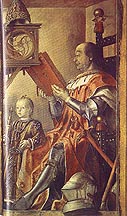
Portait of Frederigo
da Montefeltro and his son Guidobaldo: wearing the armor in which he made
his military reputation and reading a large manuscript, Federigo is shown as
both magnificent and wise, the exemplar of arms and of letters. Each element
of the picture adds to this argument. The duke's ermine-edged cloak and the
sceptre of his papal vicariate refer to the legality with which he held power.
He wears the heavy gold and enamelled chain of the chivalric Order of the Ermine;
around his calf he find the Order of the Garter, given to Federigo by King Edward
IV of England in 1474. The young Guidobaldo acts as a page-boy, carrying the
sceptre which he would inherit in due course. Appearing as a virtuous signore,
one acknowledged by the kings of Europe, there is no hint of the fact that Federigo's
accession in 1443 after his half-brother was assassinated was far from straightforward.
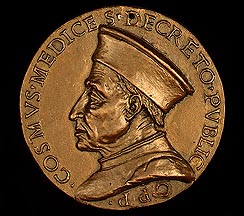
Cosimo de' Medici (1389-1464), Pater
Patriae, obverse, c. 1465/1469
bronze, diameter: .078 m (3 1/16 in.)
Inscription: COSMVS MEDICES DECRETO PVBLICO P[ater] P[atriae]
(Cosimo de Medici, the Father of the Country by Public Decree)
|
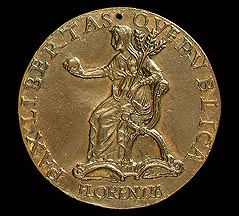
Florence Holding an Orb and Triple
Olive-branch, reverse, c. 1465/1469
bronze, diameter: .078 m (3 1/16 in.)
Inscription: PAX LIBERTAS QVE PVBLICA; across bottom: FLORENTIA
(Public Peace and Liberty/ Florence)
|
The Renaissance Medal
Excerpt from Laurie Schneider Adams, Italian Renaissance
Art, p. 145: A feature of the Classical revival in fifteenth-century
Italy was the production of medals, usually made of bronze or lead.
They were inspired by imperial Roman coins, which were smaller than
the medals but similar in design --a bust-length profile of an emperor
on the obverse, a emblem on the reverse, and an inscription.
|
|
|
|
Augustus,
Denarius, 19 B.C.
|
During the Renaissance, medals were commissioned by various
rulers and wealthy families as a way of circulating their images in
portable, relatively inexpensive form. In addition, the message conveyed
by the emblem or scene on the reverse could serve the function of political
propaganda. To a certain extent, the iconography of a medal and its
inscription provide biographical insights into the patron. Sometimes
medals were struck to commemorate the design of a building in which
case they can be useful architectural documents.
|
Excerpt from Vincent Cronin, The Florentine Renaissance, chapter entitled
"The Republic and the Medici":
/p. 59: The political development of Florence in the fifteenth century is intimately
linked with three generations of a single family.
The first Medici of consequence probably practised medicine, for the name is
a shortening of dei Medici -'of the doctors'- and the family blazon,
five red roundels or palle, probably represent pills or cupping glasses....
The Medici are heard of as a middle-class family during the fourteenth century
with political leanings toward the popolo minimo, lesser guilds, but
they remained unimportant until Giovanni di Bicci de' Medici founded a bank
specializing in accounts with the Roman Curia....
Giovanni married Piccarda, daughter of one Odoardo Bueri.... In 1389 Piccarda
gave birth to her first son, Cosimo. He received the usual primary education,
then /p. 60: took a step that influenced him for life: from the ages of fourteen
to seventeen he studied the classics in the house of Roberto de' Rossi, a rich
bachelor who had learned Greek from Emmanuel Chrysoloras.... Cosimo became an
enthusiast for the new learning and planned a journey with Niccolò Niccolo
to look for Greek manuscripts in the Holy Land, but his father, whose shelves
held only three books --the Gospels, the Legend of St. Margaret, and a sermon
in Italian-- doubtless did not sympathize with this new kind of pilgrimage.
Anyway, Cosimo started at once in the family bank....
In 1414 Cosimo made an excellent marriage to Contessina Bardi, whose family
were Giovanni's partners, and undertook his first important job....
/p. 61:In 1424 Cosimo became branch agent of the Medici bank in Rome, a responsible
post because Rome was the most profitable branch in relation to invested capital,
the yield exceeding 30 per cent....
On his father's death in 1429 Cosimo became head of the bank and Florence's
second richest citizen. The classics --particularly a treatise on economics
attributed to Aristotle-- had given him a different attitude toward wealth from
old Giovanni's. Cosimo believed that in so far as virtue was action, money could
foster virtue. As his friend Poggio expressed it in a dialogue Concerning
Avarice, private and public life would be ruined if each man earned only
what is strictly necessary. "Money is an indispensable goad for the State,
and those who seek money must be considered its basis and foundation."
This more positive outlook towards money combined with Cicero's more positive
outlook towards citizenship. Cosimo had already stood for, and held, office;
now, as the head of the family, he decided to follow an active political career.
Here it becomes necessary to look at Florence's constitution.
Citizenship was confined to members of the guilds, that is, to men following
a recognized profession or trade. Out of an estimated male population over twenty-five
of 14,500, perhaps 6,000 were citizens: that is, they had the right to vote
and hold office. But the important thing is that the ranks were open. Anyone
[male that is], whatever his birth, might become a citizen by matriculating
into one of the guilds. When it came to filling Councils or magistracies, members
of the Greater Guilds --wool and cloth merchants and professional men-- were
given a marked numerical advantage --roughly in the ratio of three to one--
over members of the Lesser Guilds --carpenters, blacksmiths, harness-makers
and so on. Florence, then, was a republic with, for that time, a widely based
franchise, but its constitution favoured the merchant class.
/p. 62:
Excerpt describing Cosimo de' Medici from Gene Brucker, Renaissance Florence:
p. 119: Cosimo de' Medici ...[was] the most prominent citizen that reached manhood
in the early fifteenth century. Vespasiano da Bisticci's biography of Cosimo
is laudatory and uncritical, but it is an honest evaluation of the man, /p.
120: and depicts him as he was seen by the majority of his fellow-citizens.
No modern biographer has succeeded in penetrating the surface of Cosimo's personality,
of exposing the man behind the public facade. We can use this facade, however,
to measure some of the changes that had occurred in the life style of the patriciate.
Cosimo's authority derived from his great wealth and his leadership of a faction.
Vespasiano da Bisticci described a conversation between Cosimo and a political
rival, in which the former articulated his political philosophy: "Now it
seems to me only just and honest that I should prefer the good name and honor
of my house to you: that I should work for my own interest rather than for yours.
So you and I will act like two big dogs who, when they meet, smell one another
and then, because they both have teeth, go their ways. Wherefore now you can
attend /p. 121: to your affairs and I to mine." He demonstrated a particular
talent for working behind the scenes, achieving his goals by manipulating others.
His instruments were the bonds of obligation by which he tied his supporters
to himself. Vespasiano wrote: "He rewarded those who brought him back [from
exile], lending to one a good sum of money, and making a gift to another to
help marry his daughter or buy lands...." His political enemies were not
killed but exiled; the refusal to shed blood was characteristic of this cautious
politician who gained his objectives by less flamboyant methods. In one sense,
his style represented the triumph of the mercantile mentality. He typified the
rational and calculating entrepreneur, the shrewd, toughminded realist who had
banished passion and emotion from politics.
The material dimensions of Cosimo's life also reflect significant
innovations in the patrician mode of living. The construction of a massive palace
on the Via Larga provided the arena for a more refined and luxurious style of
existence, which set the pattern for the Florentine upper class. Although Cosimo
deliberately affected the manner of an old-fashioned merchant with simple tastes,
his living style signalled the abandonment of such traditional virtues as austerity,
thrift, and frugality, and the acceptance of ostentation as a socially desirable
trait. The new ethic received political sanction with the repeal or the nonenforcement
of sumptuary legislation, a characteristic feature of communal policy in earlier
times. Seven years after Cosimo's death, his grandson Lorenzo stated that the
Medici had spent over 600,000 florins for public purposes since 1434, and he
remarked that this expenditure "casts a brilliant light upon our condition
in the city." The living standard in the Medici palace was more luxurious
than Cosimo's ancestors had ever known. This expenditure for magnificent decor,
costly furnishings, and elegant clothing was designed to provide an impressive
setting for prominent guests, to create an image of Medici (and Florentine)
wealth and taste. Cosimo was host to both the German emperor Frederick III and
the Byzantine emperor John Paleologue, as well as other, less distinguished
princes of church and state who dined and lodged in the palace on the Via Larga,
or in the villas at Careggi and Cafaffiuolo. The Medici were not the only /p.
122: Florentine family to dispense lavish hospitality, but the scale and opulence
of their entertainments marked them as the city's most illustrious house. A
visit to the Medici household was a dazzling experience, as young Galeazzo Maria
Sforza, son of the lord of Milan, testified in letters to his father Francesco.
This product of a courtly milieu extolled the beauties and charms of the villa
at Careggi, and praised the musical and dramatic entertainments which were provided
for his amusement.




